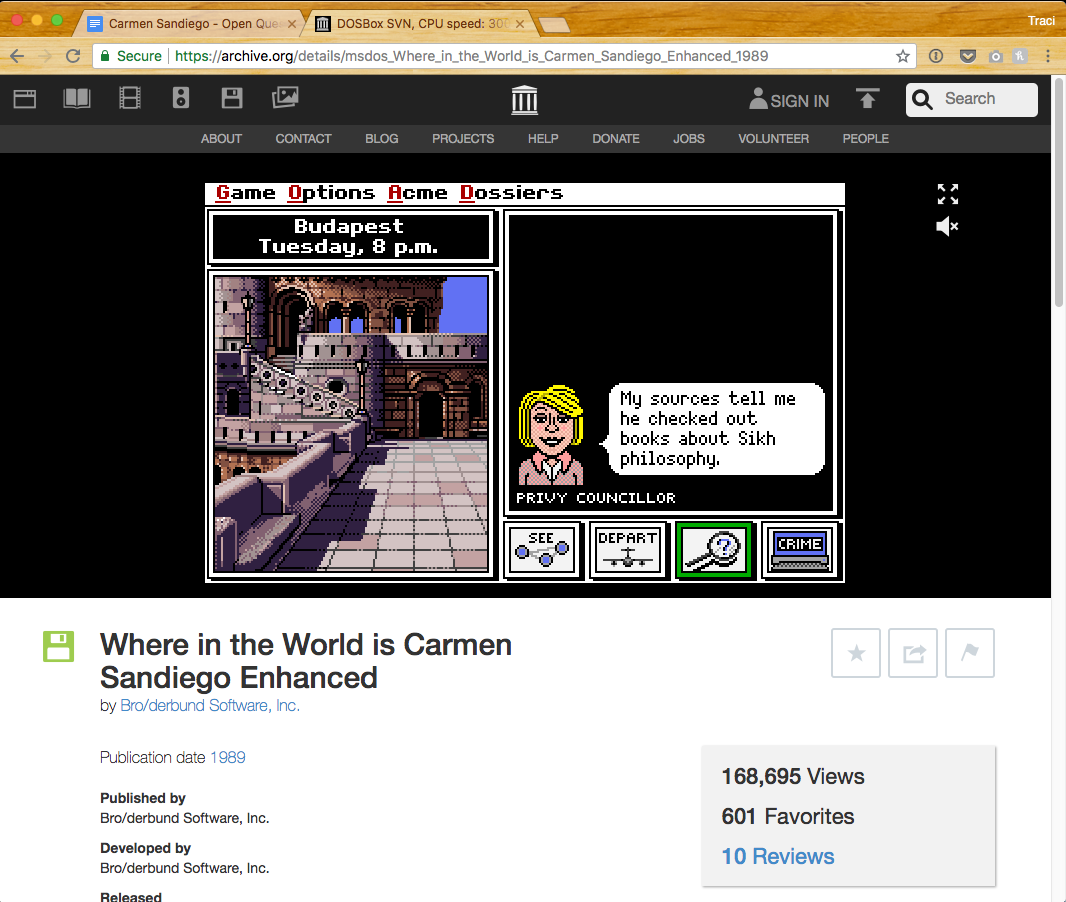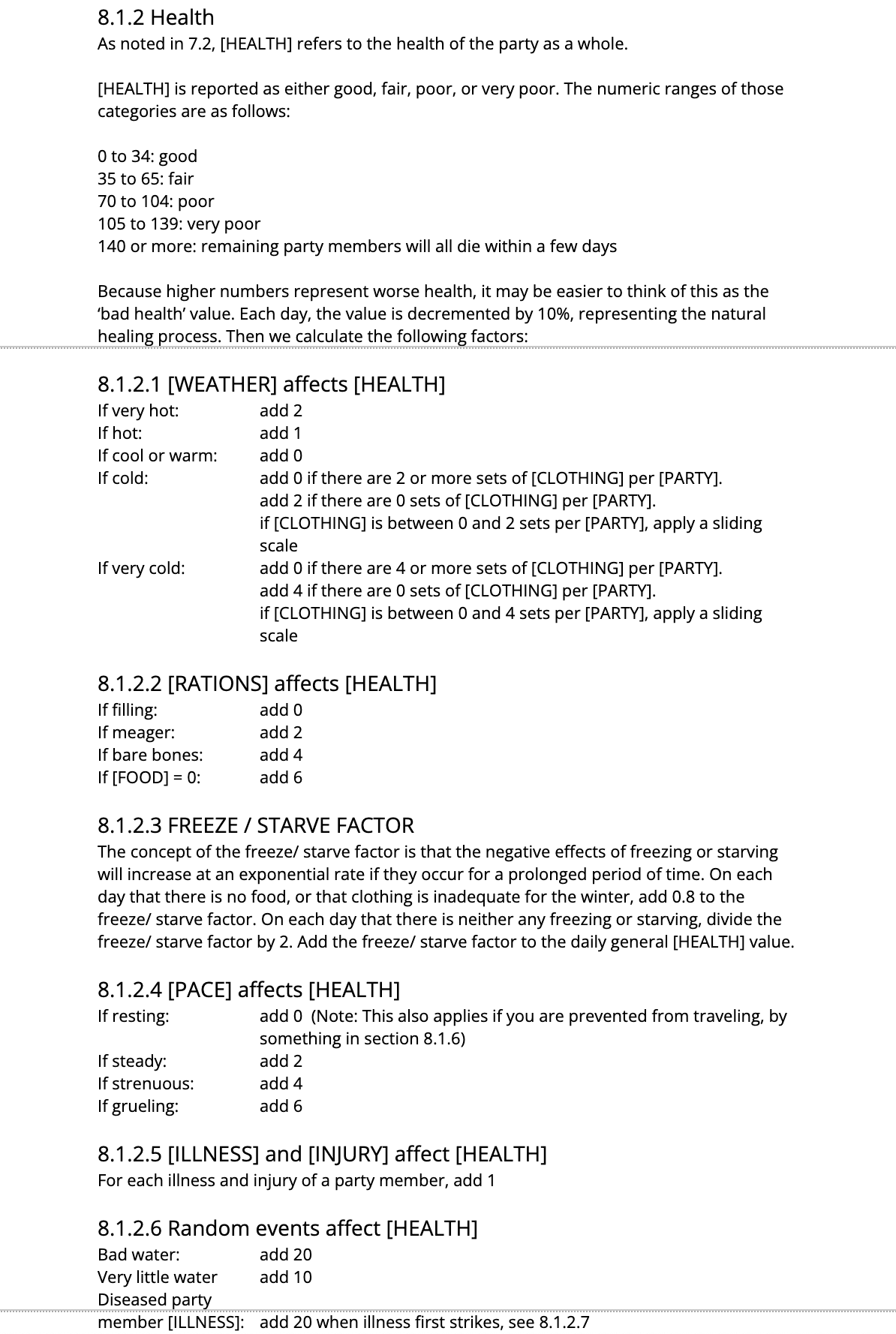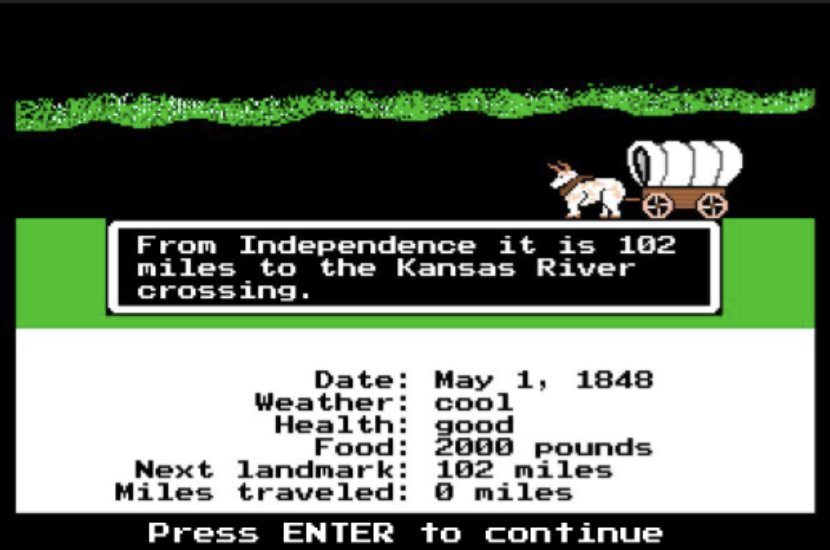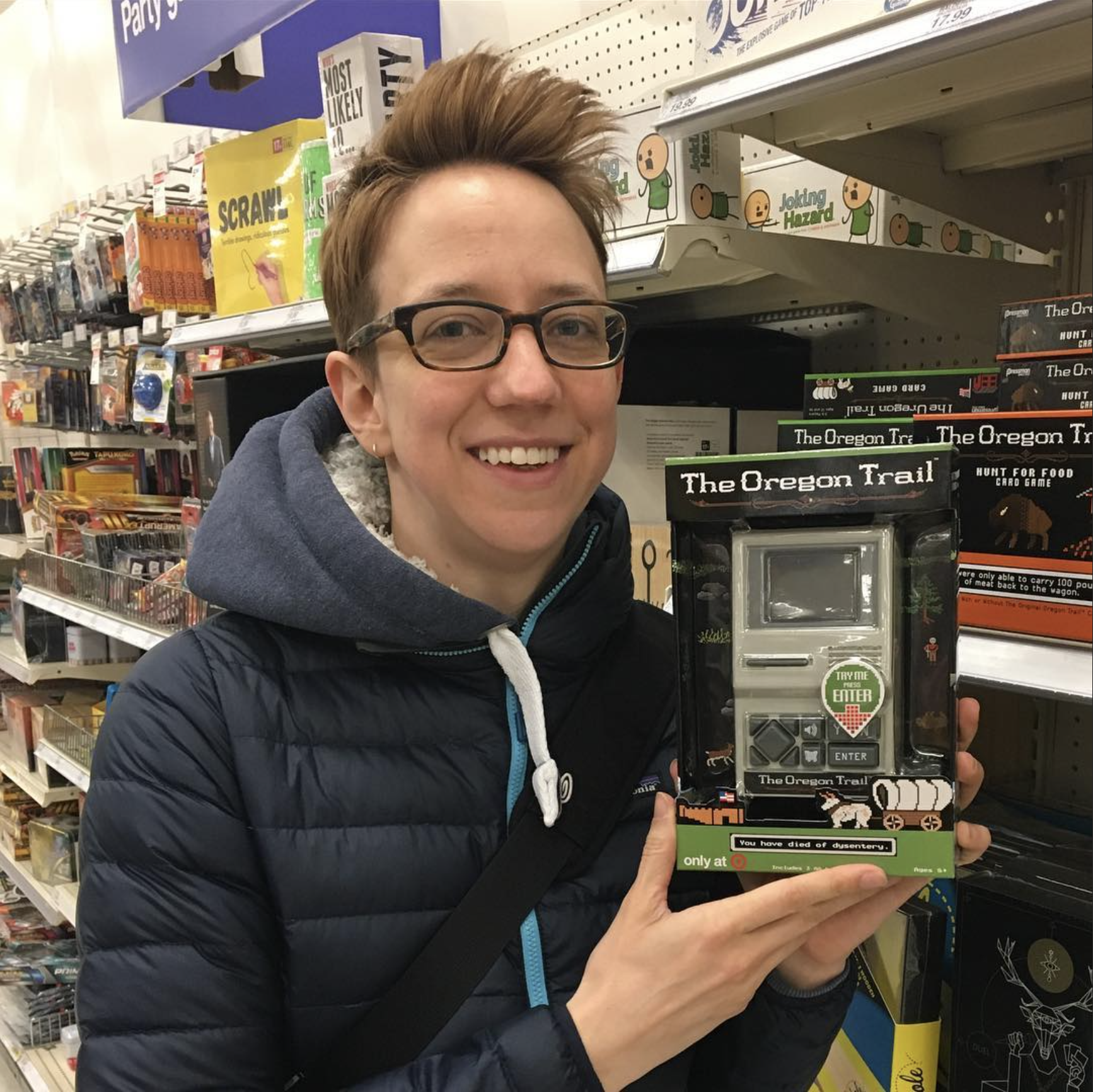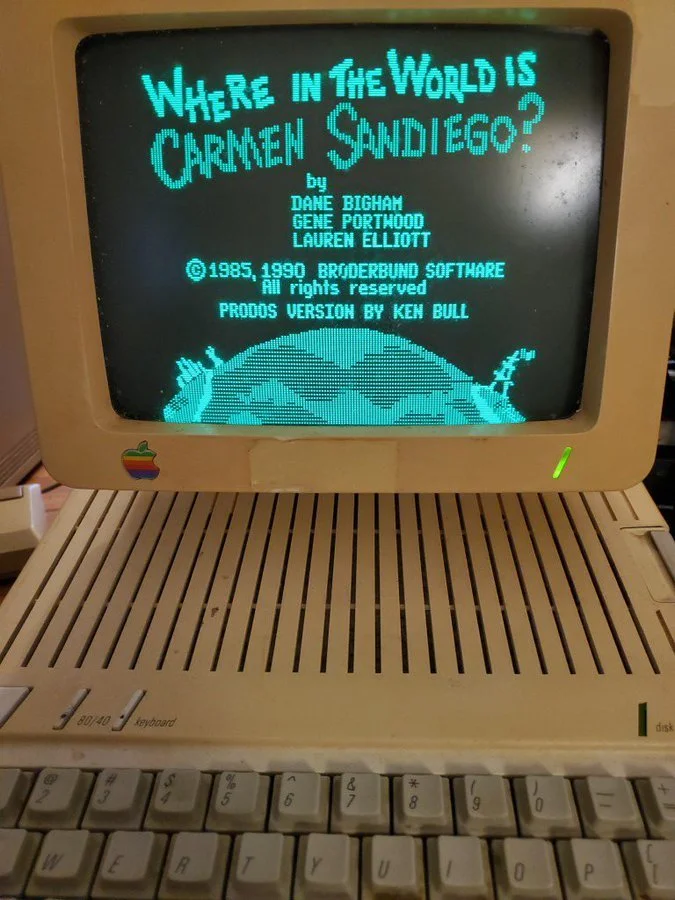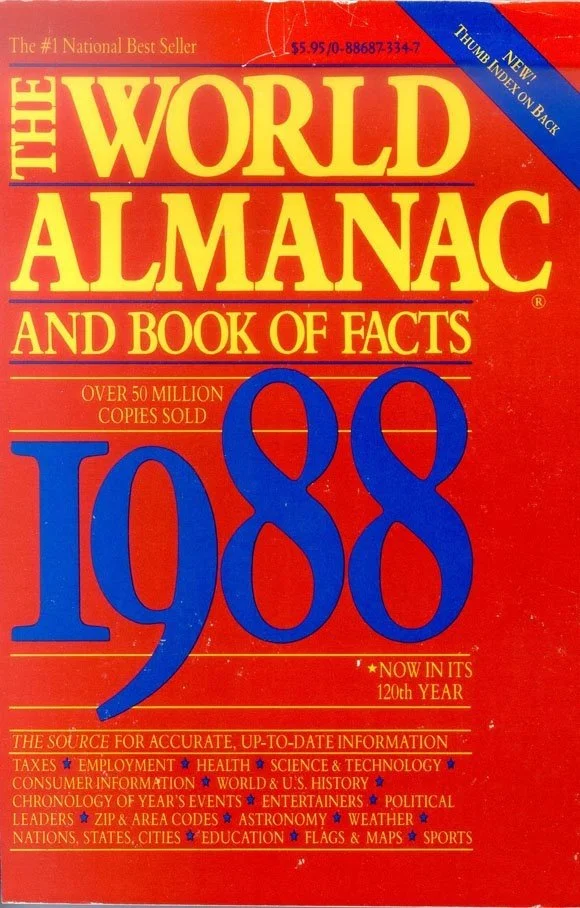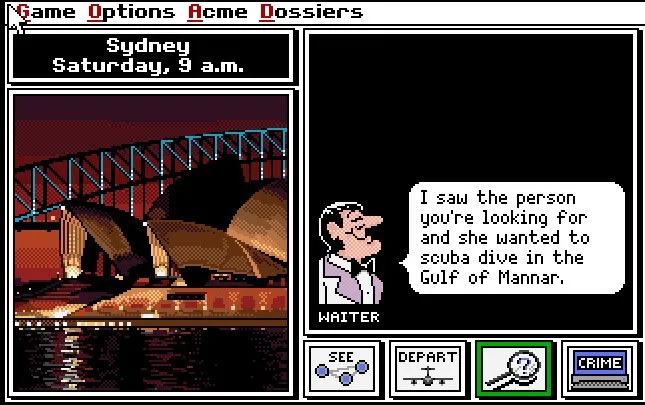The Oregon Trail &
Where in the World is Carmen Sandiego
TITLE Game Designer
RESPONSIBILITY writing the functional spec documentation
COMPANY Basic Fun
TEAM SIZE 2 people: the electronic components engineer and me
It was an honor to be given the opportunity to write the functional specifications for the handheld electronic toy version of two games loved by generations: The Oregon Trail and Where in the World is Carmen Sandiego. Toy company Basic Fun had the license for these games, and a goal to reissue the classic game play from bestselling editions of decades past in handheld form. They had the games’ graphics, but they did not have any documentation about how the games work. That’s where I came in!
Design Process
Working on these two projects felt like doing forensic game design. I knew these games by heart when I was child, but how did they work? What determined who got sick along The Oregon Trail? How did Carmen Sandiego decide what loot to steal, and which city to hide in? How would I even know all of the questions I needed to ask?
When I came on board, the engineer who designed the electronic components had already determined what the plastic casing would look like, and what buttons the toy hardware would have. My mission was to write a complete functional specification for the game programmers to follow.
My process for Where in the World is Carmen Sandiego ended up looking a lot different from my process for The Oregon Trail, but I started both projects in the same place: playing through the games several times on The Internet Archive, and taking detailed notes.
The Oregon Trail
The Oregon Trail came first, in the spring of 2017. I had 3 weeks to write a complete functional specification. As I was beginning to sink my teeth into the project, I was beyond delighted to discover the book You Have Died of Dysentery by the lead designer of the 1985 edition of the game, R. Philip Bouchard. It’s a really great book, if you’re interested in the design of educational games. The history of The Oregon Trail starts with the first edition of the game that was created for teletype and paper tape terminals in 1971! This book is mostly an anecdotal retelling of the design decisions the 1985 team made and why. I still had a lot of holes to fill in.
At its core, The Oregon Trail is a text-based strategy game with graphics. Players always start a new game in a shop in Independence, Missouri. I had to start working on the game design document somewhere, so it made sense to begin with everything that happens every time a player starts a new game. That included the text the game should display, the choices players are given, how players make their selections, and what data needs to be stored in memory.
Because the game always follows the same linear progression through the same landmarks, I created sections of the document that detailed what players could do at each one, and how they would do them. Another section detailed what they could do along the trail between. Then I wrote sections that explained what happens at river crossings, and places where there’s a fork in the trail. My work was all about observing what the 1985 game contained, and solving the puzzle of how to make the game work in a handheld plastic toy with a limited number of buttons.
Throughout the document, I noted when a value was plugged in from an algorithm, or from a stored value, such as names in the player’s expedition party. That made it easy to simultaneously write separate sections in the back of the document for values to store, and algorithms to calculate things like weather, health, and the occurrence of chance events like encountering a robber.
It was up to me to determine what each of these algorithms and stored values should be, as well as what order to place them in the document, so the document would be easy for the programmers to use.
The Oregon Trail is surprisingly complex. The player’s current location on the trail factors in to the weather algorithms. Very hot weather can affect health, and very cold weather can too, if the player’s clothing supplies are low. Food supply also affects health. The player’s pace along the trail is determined by the health of their team of oxen. All of these calculations (and more!) are made by the game every single “day” that passes on the trail screen.
There are two parts of the game that stand apart from the core game play of The Oregon Trail, so it made sense to have separate sections in the document for each of them.
The hunting activity is a way for the player to increase food rations for their party. The type and quantity of animals the player encounters is determined by their current location on the trail.
There is also a lengthy Columbia River rapids journey that players must pass at the end of the game to complete their journey to Willamette Valley, Oregon.
Results
After a few weeks of hard work, I was proud to deliver the game design document to Basic Fun on time for hand off to their development team. After a few minor updates, we had a final draft.
The game was released in early 2018, and was initially a Target exclusive. It received kind reviews on Gizmodo, Polygon, and The Verge. As of 2024, it has a 4.6 average out of 5 star review score on Amazon.
Forgive my disheveled appearance
while running errands at Target! 😆
Where in the World is Carmen Sandiego?
Carmen Sandiego was much easier to decipher a specification for, even though I didn’t have much information about the original game beyond a couple of wikis. When Basic Fun rehired me in late summer 2018 to deliver a spec for this game, I relied more heavily on the Internet Archive emulator and taking my own detailed notes to determine what the game’s milestones are. What I discovered often disagreed with what the FAQs said, but that didn’t matter much.
The original edition of Carmen Sandiego was played by kids at a computer terminal at school, in the library, or at home. The game used to ship with a copy of the World Almanac and players were expected to look up facts when they didn’t understand a clue. This portable edition of the game would be played by kids anywhere they happened to be. Instead of a copy of the World Almanac, kids would likely ask a nearby adult for help understanding a clue, or search the internet. These factors influenced design decisions I made as I adapted the game for a handheld interactive toy.
Where in the World is Carmen Sandiego is a much simpler game than The Oregon Trail. When the game begins, players are given news about loot that has been stolen from a major world city. Their mission is to figure out who the thief is, obtain a warrant, and track them down to apprehend them.
Because Carmen Sandiego is simple in structure, it didn’t take much time to write the game design document. It’s a straight forward experience every play session, so it was easy to devise a functional spec simply by playing and observing the game itself.
So what makes a simple game so replayable and beloved by many? The pretend play action of travelling around the world and testing your knowledge of cities on 6 different continents. A key feature of the design is a deep dataset for each of the 30 cities Carmen Sandiego and her henchmen travel to.
Every city has the potential to be where a game starts, so every city has 3 items that could be the stolen loot. These are often famous objects, but because the player doesn’t have to devise the location the object is tied to, they can also be obscure or fanciful. Every city also has 3 sets of fun facts players are told about it, plus multiple facts in 9 different categories that plug into concatenated sentences in the clues townspeople give the player.
Players start in the city the loot was stolen from, where they can visit up to three venues to ask for clues about who the suspect is and where they headed next. The player must then choose from a list of three world cities to fly to, aiming to follow in the suspect’s tracks. The goal is first to have enough information about the suspect to gain a warrant, and follow their travels through several cities correctly to catch up with them and make an arrest before the mission deadline.
I had some of the data the original game used, but because I expected kids would be relying on parents and the internet to help them pursue suspects instead of the World Almanac, I decided we needed an important design update: making sure all the facts were up-to-date and common knowledge, or at least easily Googleable. The original game had a clue about potash for Montreal. Sure, potash might be one of Canada’s main exports, but how many people are aware of that? It’s more fun for both kids and the adults helping them if the clue says the suspect was overheard talking about hockey pucks and maple syrup.
Designing for family involvement was more important than recreating the original game with as few changes as possible.
Results
After a couple of weeks of work, I delivered the design spec document and 3 cooresponding spreadsheets of values on suspects, destination cities, and travel times.
The game was released in October 2019. As of 2024, it has a 4.6 out of 5 star average review score on Amazon. It is currently discontinued and people are reselling it for more than twice the original MSRP of $20!


